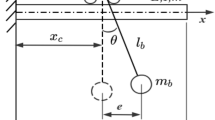Abstract
Based on the Lagrange classical stability concept, the approaches and corresponding equations for determining conditions for providing a static and tip-over stability of a two-chain suspension arrangement have been developed. Specifically, it has been proven that the arrangement is in the stable position of equilibrium if the cargo centre of gravity is placed within the isosceles triangle (named as static stability triangle). The base of this triangle is the base of the secondary suspension, and its height is a function of the geometric peculiarities of the arrangement and ratio between mass of spreader and cargo unit. Comparative tip-over stability analysis of the arrangements with different geometric peculiarities and configurations has been also performed.










Similar content being viewed by others
Abbreviations
- S.S.T.:
-
Static stability triangle
- c.c.g.:
-
Cargo unit centre of gravity
- r.c.g., R:
-
Resultant centre of gravity [the sum of forces (masses) p and P c]
- S :
-
Point of suspension of the arrangement
- T :
-
Apex of the S.S.T.
- SA, SB:
-
Primary slings/slings of the primary chain of suspension
- AC, BD:
-
Secondary slings/slings of the secondary chain of suspension
- AB:
-
Spreader
- CD:
-
Base
- SZ:
-
Suspension line (a vertical line through point S)
- L :
-
Intersection point between line segment KO and vector P c in Fig. 2
- φ :
-
Primary suspension angle (angle between a primary sling and perpendicular to the spreader), degree
- γ :
-
Secondary suspension angle (angle between a secondary sling and vertical line in the upright position of the arrangement), degree
- v :
-
Height of the primary suspension, metre
- l :
-
Half of length of the spreader, metre
- r :
-
Length of a secondary sling, metre
- y :
-
Transverse coordinate of the c.c.g. (with respect to suspension line SZ0), metre
- z :
-
Vertical coordinate of the c.c.g. (above base CD), metre
- p :
-
Weight (mass) of spreader AB, ton
- P c :
-
Weight (mass) of a cargo unit, ton
- α:
-
Tilting angle of the primary suspension, degree
- β :
-
Slewing angle of the secondary suspension on condition that γ = 0, degree
- U(α,β):
-
Forcing function of the arrangement, t × m
- П(α,β):
-
Potential energy of the arrangement, t × m
- Q α :
-
Generalized force (as function of α), t × m
- Q β :
-
Generalized force (as function of β), t × m
- z m :
-
Height of the S.S.T. (maximum allowable vertical distance of the c.c.g. from base CD), metre
- F χ, F θ :
-
Half of perimeters of corresponding triangles, metre
- m χ, m θ :
-
Radiuses of inscribed circles of the triangles, metre
- χ :
-
Angle between one secondary sling and perpendicular to spreader AB at which another secondary sling (together with base CD) composes a straight line segment, so that the entire secondary suspension composes a triangle, degree
- θ :
-
Angle at vertexes of the S.S.T., degree
- ω, ε, ζ, θ 1, θ 2 :
-
Angles at vertexes of corresponding triangles, degree
- 0:
-
Arrangement is in the upright original position
- m :
-
Arrangement is in the critical position [when c.c.g. is placed at the left (or right) side of the S.S.T.]
References
Butenin N.V., Lunts Y.L., Merkin D.R. (1979) Theoretical mechanics course. Volume 2. Dynamics. Moscow, Nauka—544p. (Бутенин Н.В., Лунц Я.Л., Меркин Д.Р. Курс теоретической механики. Том 2. Динамика. Наука: Гл.ред. физ.-мат. лит. Москва. 1979—544с.) http://padabum.com/d.php?id=31339
Fujioka D.D., Rauch A., Singhose W., E., Jones T. (2009). Tip-over stability analysis of mobile boom cranes with double-pendulum payloads. 2009 American Control Conference. Hyatt Regency Riverfront, St. Louis, MO, USA, p. 3136-3141
Kaps H. (2009) BBC guideline. Safe solutions for project cargo operations. Version 1.0. BBC chartering & logistics GmbH&Ko. KG—68p. http://deckofficer.ru/titul/study/item/safe-solutions-for-project-cargo-operations
Kaps H. (2013) Stability of cargo suspension arrangements. Transport Information Service (TIS) from the German Insurance Association. www.tis-gdv.de/tis_e/inhalt.html
Leine R. (2010). The historical development of classical stability concepts: Lagrange, Poisson and Lyapunov stability. Nonlinear Dynamics 59(1–2):173–182
Targ S.M (1986). Short course of theoretical mechanics. Vyshaya Shkola. Moscow,—416p (Тарг С.М. Краткий курс теоретической механики. Высшая школа. 1986—416с.) http://web-local.rudn.ru/web-local/uem/ing/ter_mex/9.pdf
Author information
Authors and Affiliations
Corresponding author
Rights and permissions
About this article
Cite this article
Nikitin, Y.V. Static and tip-over stability analysis of two-chain suspension arrangements for large-scale cargo operations. WMU J Marit Affairs 13, 101–126 (2014). https://doi.org/10.1007/s13437-013-0054-5
Received:
Accepted:
Published:
Issue Date:
DOI: https://doi.org/10.1007/s13437-013-0054-5




